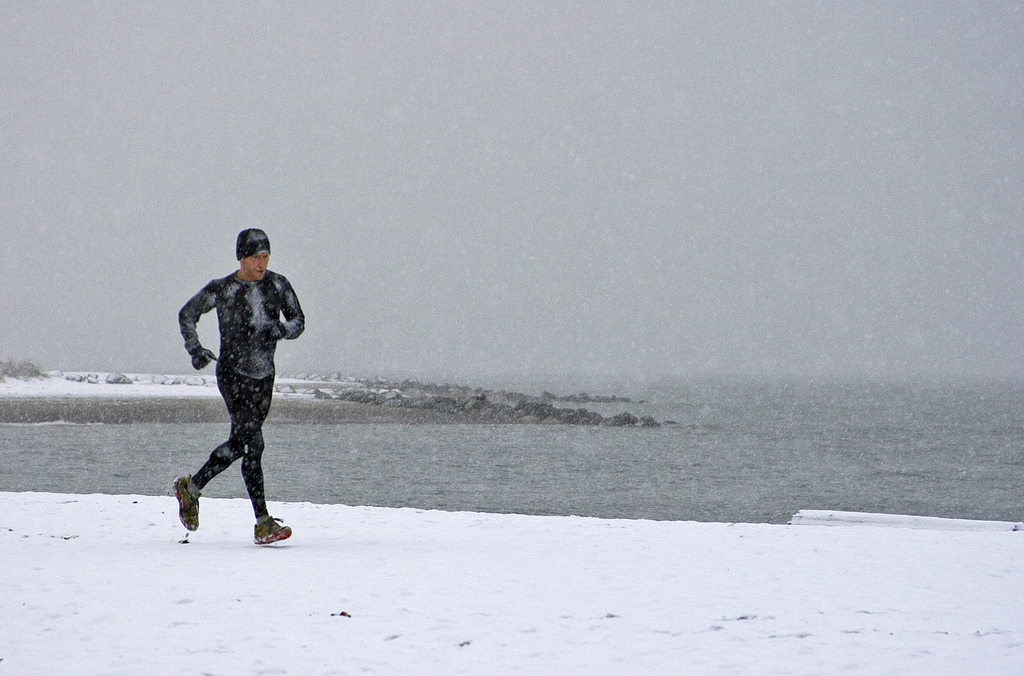The cold weather has arrived! Winter running shows the true character of a runner; however, it can be intimidating if you aren’t prepared for the lower temperatures. But just as with running in the rain, running in colder weather can be quite enjoyable if you are properly prepared. Here are some tips to keep comfortable while running in this winter.
Running in Cold Weather
Get motivated
Perhaps the hardest part of cold weather running is simply finding the motivation. The best way to keep your training on track is to set a specific goal. There are several winter runs, such as ‘Chilly Chases’ or Hypothermic Halfs. Better yet, consider winter destination race in a warmer climate. If you can’t find a race, consider setting a monthly mileage goal, or committing to a running streak of at least a mile a day for a set period.
Another great motivating technique is to sign up for a clinic or run with a group. Not only will you have peer pressure to get you out, you will have friends to talk to along the way—and share in the feeling of accomplishment after running on particularly cold days!
Dress for success
Over-dressing is easy to do in when it is cold out. You want to be warm without perspiring so much you get a chill. The rule of thumb is to dress as if it is 20 degrees F/10 degrees C warmer than the thermometer. This means that you will feel slightly cool when you start. But don’t worry, running will heat your body up pretty quickly.
More often than not, you’ll find yourself getting quite warm during your run. Instead of wearing one heavier jacket, dress in layers of lighter technical clothing that will wick perspiration from your body. You will also be able to unzip or remove layers to moderate your body temperature as you run. For your lower body, I recommend running tights when the weather drops below 40 F/5C. For very cold weather, men should invest in wind briefs.
As a lot of heat is released through your head and hands, I usually wear gloves and a hat—even when I’m still wearing shorts and a t-shirt. In very cold weather, try mittens which are warmer than gloves. If the weather is very cold, or windy, cover any exposed skin like ears, cheeks, and nose with a layer of skin lotion, vaseline, lip balm, or even BodyGlide.
If you are not sure what you should wear on for a given run, Runner’s World has a great web app that allows you to input information—including temperature, wind, and time of day—and suggests what you should wear.
When running on snow or ice, I suggest wearing trail shoes or running traction devices like Yak Trax. These will give you better traction and stability. If your feet get cold, invest in good thermal running socks, instead of wearing thicker wool or doubling up.
And remember that drivers aren’t necessary expecting to see you out running in colder weather (and can’t stop as quickly when they do), so be sure to dress to been seen and be extra careful at intersections. This is especially important when running in the mornings or evening when it is dark.
Warm up before heading out
While warming up is always important, it is especially important to do thoroughly in colder weather to prevent injuries. Your body will warm up more slowly in cold weather, so before heading outside, take at least five minutes to do some light movements indoors to get the blood flowing.
Indoor warmup suggestions include running up and down your stairs, jumping rope, doing some jumping jacks, or a few sun salutations if you are into yoga. This movement will help you feel more comfortable at the beginning of your run and condition your muscles, tendons and connective tissues for use. Think of it in a similar way to warming up your car on a cold day before driving off.
Another tip for colder days, especially if you run in the morning is to ‘pre warm’ your major leg muscles by taking a warm shower BEFORE your run. You can also use a menthol muscle gel to create some chemical heat in your muscle and open up your blood vessels. This is especially beneficial for early morning runs after your muscles have rested all night.
Shield yourselves from the wind
On a day with higher wind speed, start your run into the wind and finish with it at your back. There are few things worse than a cold wind at your face on your way back home, especially after you have broken a sweat. Better yet, break your wind exposure into segments, changing directions every 10 minutes or so to give yourself a break from the headwind.
Another option is to look for wind protection such as downtown building or tree lines in parks. This also gives you to opportunity to mix up your routes and keep things interesting.
Keep hydrated
Remember to drink water on any run over an hour. Just because it is cold doesn’t mean you don’t need to hydrate; your body is still giving off a lot of heat. Be warned that many of your favourite public water fountains will be turned off for the winter, so you may need to carry your own.
To avoid ice-cold water, start with warm water and use insulated water bottles/hydration packs. The same insulation that keeps the cold in during the summer also keeps it out in the winter. If you run with a fuel belt, see if you can fit it under you at least 1 layer of clothing.
Your lungs won’t freeze
Although it may feel like you are breathing in ice during your first few colder weather runs, don’t worry, your lungs aren’t in danger of freezing. The cold air gets warmed up is by your body before it reaches your lungs. Any ‘lung burn’ you may feel will go away after a few cold weather runs. But, if you find the cold air unbearable, consider wearing a face mask to help warm the air.
Timing is everything
Whenever possible, run during daylight hours, and the warmer times of the day. Instead of scheduling your long runs for first thing on Sunday morning, consider running in the mid afternoon, and doing your weekend chores/errands before hand.
Post run ‘warm down’
After your run, your core temperature will begin to drop immediately, so get indoors as soon as possible and change quickly out of your wet clothes as the perspiration you have accumulated will start causing a chill.
Don’t dread the treadmill
Although I’m guilty of calling it the ‘dreadmill’, a treadmill is a great training tool during the winter months. This is especially true for speed work and hills that can be dangerous in wet or icy conditions. Doing more intense workouts inside, also helps make sure you muscles are warm to lower the risk of injuries.
Just do it!
Other than that, just get out there and do it. It might be tough at first, but people will envy your willpower when they see you braving the cold conditions. Better yet, come spring they’ll be impressed by how much faster you are!
Your turn
What keeps you running outside when the weather gets cold? Leave a comment and let me know.











